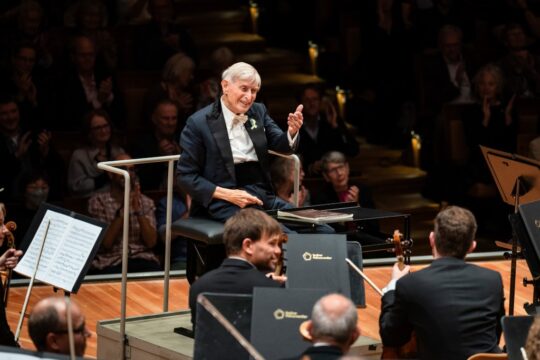Sich von seinem Selbst-Ich trennen;
Doch probier' er jeden Tag,
Was nach außen endlich, klar,
Was er ist und was er war,
Was er kann und was er mag. »
"No one will know themselves,
Separate themselves from their self.
But let them try every day,
What finally, clearly, outwardly,
What they are and what they were,
What they can and what they like."
(GOETHE)
Richard Strauss's Metamorphosen or Suspended Time
The theme of metamorphosis has always fascinated Richard Strauss and can be found in several of his compositions, operas, and symphonic works. Thus, in April 1945, Strauss completed the composition of one of his last major scores, Metamorphosen, subtitled "Study for Twenty-Three Solo Strings." In the midst of the chaos caused by the bombing of the Opera House in Munich, his hometown, the aging composer drew painful inspiration for this one-movement orchestral piece, where tonal and harmonic "metamorphoses" unfold while depicting the transformation of the world of yesterday, symbolized by Beethoven's Funeral March from the Eroica Symphony that Strauss explicitly quotes. This Beethovenian theme runs through the work, undergoing constant transformations until the final literal quotation under the mention "in memoriam." Goethe's readings, a theorist of the transformation of plants and animals, must also have influenced Strauss, to the point of setting to music the verses of the great German poet quoted at the beginning, which could also summarize Blomstedt's state of mind in the autumn of his career.
Metamorphosen is a relatively short, deep, and complex piece. It consists mainly of a long adagio, with a more agitated central section. The whole reflects a musical journey through the human soul. The beginning, calm and meditative, may evoke a form of deep introspection, while the more troubled central section perhaps represents the challenges and struggles of existence. Metamorphosen seem to express a reflection on inner transformation and the evolution towards wisdom. It is a work that invites contemplation while offering a musical experience of great emotional and intellectual richness. After a very slight intonation issue at the beginning of the performance, the tremolos of the violins bring forth a melody that is as much reminiscent of Mahler's adagios as it is of the enveloping nostalgia of the Four Last Songs, in a swan song with arabesques that become less elegiac as the strings' volutes unfold. In a meticulous exploration of the score, as is always the case with Blomstedt, the sonic journey reveals the work as a direct but internalized sequel to Death and Transfiguration, but one also occasionally thinks of the heady sounds of Schoenberg's Transfigured Night, while variations around the Funeral March from the Eroica unfold. Each section of the work is an episode in which time seems to expand and contract, creating a listening experience that challenges perception. Thematic variations, changes in dynamics, and contrapuntal elements combine to create a temporal kaleidoscope where each moment glistens like the facets of an introspective black diamond: one constantly oscillates between transparency and opacity. At the end of the performance, it is quite remarkable to see the Maestro applaud the twenty-three musicians, as if he himself were captivated by the excellence of his performers. This is also a hallmark of his legendary humility.
Beethoven’s Eroica: a Sonic Odyssey
In the second part of the concert, there is a change in scale, noticeable from the first measures: Blomstedt, without a score this time, shapes the music with extraordinary gestures, twists, magical movements, one doesn't know, sculpting the space, indicating his intimate connection with the work. One must see him paint curves, inflections, and signs immediately followed by his musicians: one can feel that he is in his element, more creative and engaged than in Strauss’s work: his direction breathes with clarity, lightness, and meticulous transparency, offering a serene vision more than epic or disheveled, served by the imperial and stratospheric Albrecht Mayer’s oboe, which dominates the entire concert.
The first movement is supremely beautiful, meticulous, without losing its coherence, even if it resists analysis because of its complexity. It is important to note that Beethoven, unlike his previous classical symphonies, decided to eliminate any introduction. The work begins abruptly with two perfect E-flat chords, played forcefully by the orchestral ensemble. Then, the first theme is softly exposed by the cellos. This theme has similarities with the sinfonia overture from the singspiel Bastien und Bastienne composed by Mozart at the age of 12 in 1768. Indeed, it is the spirit of Mozart that runs through this interpretation, with Blomstedt being light, lively, and without mannerisms. Just the music, only the music. A second motif in B-flat, played softly (dolce), appears, composed of three notes, successively interpreted by the oboe, clarinet, flute, and first violins. The second theme itself consists of a series of staccato chords, starting softly and crescendoing. In this passage precisely, the dialogue between the flute and oboe provides the highest delights: what a sonic perfection, combined with spirit and text, what a supreme elegance in this art of conducting! The development that follows is of gigantic scope, with 246 measures, making it the longest passage in any of Beethoven's symphonies. Its complexity makes it practically unanalyzable. But the orchestra's tour de force lies precisely in its ability to make the utmost simplicity heard: the exquisite alliance between Apollonian and Dionysian sides. Few orchestras and conductors succeed in this performance. A long coda concludes the movement, at the giusto tempo, without overemphasizing, without giving the haughty exaggerated demeanor that is sometimes heard. As Nietzsche suggested, Beethoven manages to create moments of suspended time through his music. Blomstedt's masterful interpretation amplifies this effect, these miraculous moments when time stands still, enveloping us in a timeless musical experience. Each pause, each transition, each crescendo contributes to the impression of a revelatory timeless experience, a secret the conductor holds. One then truly thinks of Proust:
"Without a doubt, the notes that we hear then tend already, according to their height and quantity, to cover in front of our eyes surfaces of varied dimensions, to trace arabesques, to give us sensations of width, thinness, stability, caprice. But the notes have disappeared before these sensations are sufficiently formed in us not to be submerged by those already awakened by the following or even simultaneous notes. And this impression continues to envelop with its liquidity and its 'blending' the motifs that emerge from time to time, barely discernible, only known by the particular pleasure they give, impossible to describe, to recall, to name, ineffable."1
The second movement, commonly referred to as the "Funeral March" and marked "adagio assai" in C minor, spans 247 measures. With its poignant emotional depth, Herbert Blomstedt manages to evoke an experience that is both poignant and profound, without falling into the trap of excessive pathos or elegiac exaggeration. His subtly nuanced direction allows the Berlin Philharmonic to bring out the unique timbres of the orchestra, sculpting an exceptional interpretation that anticipates the famous funeral march of the Seventh Symphony. The origin of this movement is interesting to mention: as early as 1802, in his piano sonata in A-flat op. 26, Beethoven had composed an adagio that he had called a "funeral march to celebrate the memory of a hero." This desire to pay tribute to a deceased hero is evident in this movement of the Third Symphony. The theme of the funeral march is introduced by the first violins, accompanied by deep rhythmic accents that sometimes evoke drum rolls, a characteristic that Blomstedt directs with fascinating subtlety and intensity. The skillful use of the key of C minor creates a dark and introspective atmosphere, while the passage to C major in the middle of the movement offers a temporary tonal contrast, perhaps to express hope or the celebration of life in the face of mourning. This movement sometimes allows contemplation of desolate landscapes, in a new moment of suspended time (one can feel Bruckner at work !), with restrained double basses. It is precisely this bittersweet taste, expressed by the sunlit brass and the dark, woody, and earthy sound of the double basses, so characteristic of the soul of this orchestra, that one remembers: grandeur and dignity, the now stoic heroic wisdom of a conductor at the peak of his career, twilight nobility.
The third movement, Scherzo, is marked by a fast tempo, an allegro vivace, composed of 442 measures. This movement opens delicately in an atmosphere of hurried whispers, mainly orchestrated by the strings soon joined by the oboe, always sovereign. Blomstedt's subtly energetic direction allows this passage to come to life dynamically while maintaining the clarity of melodic lines and harmonies. At the heart of the movement, the central trio makes its entrance, introducing a majestic fanfare of brass and orchestrating a harmonious dialogue between the three horns. This trio brings a welcome contrast to the agitation of the initial scherzo, offering a contrasting perspective to the listener. Blomstedt's direction, while maintaining the vivacity of the tempo, ensures a balanced and expressive interpretation of this romantic and exuberant hunting fanfare, full of verve, highlighting the virtuosity of the brass section. The ensemble reintroduces Beethoven's distinctive style, characterized by the use of tight, dense rhythmic motifs, and sometimes tinged with irony, in a frenzied, demanding race for the string instruments, in constant tension, to better foreshadow the finale, an Allegro molto in E-flat major. Conceived in the spirit of the finale of The Creatures of Prometheus, it features a series of variations based on rhythmic and melodic cells. Its pace, triumphant and jubilant, remains tastefully interpreted, without seeking effect, without excessively flattering the audience. This musical probity and high level of execution can only win a well-deserved standing ovation.
Blomstedt and Strauss: a meditation in search of lost time; Blomstedt and Beethoven: musical balance, spiritual journey, certainly far from the experimental flashes of a Harnoncourt in the past, but always a refreshing classicism and a masterful perspective, with humility as a bonus. When music gives so much to feel and think, words become superfluous to describe the moving triumph achieved by the Maestro, who comes to greet an adoring audience three times. Heroic, undoubtedly.
Philippe Rosset
September 22, 2023
1 Proust, Swann’s way



